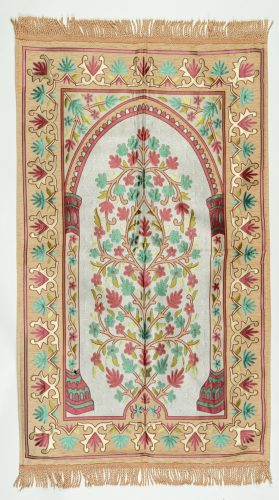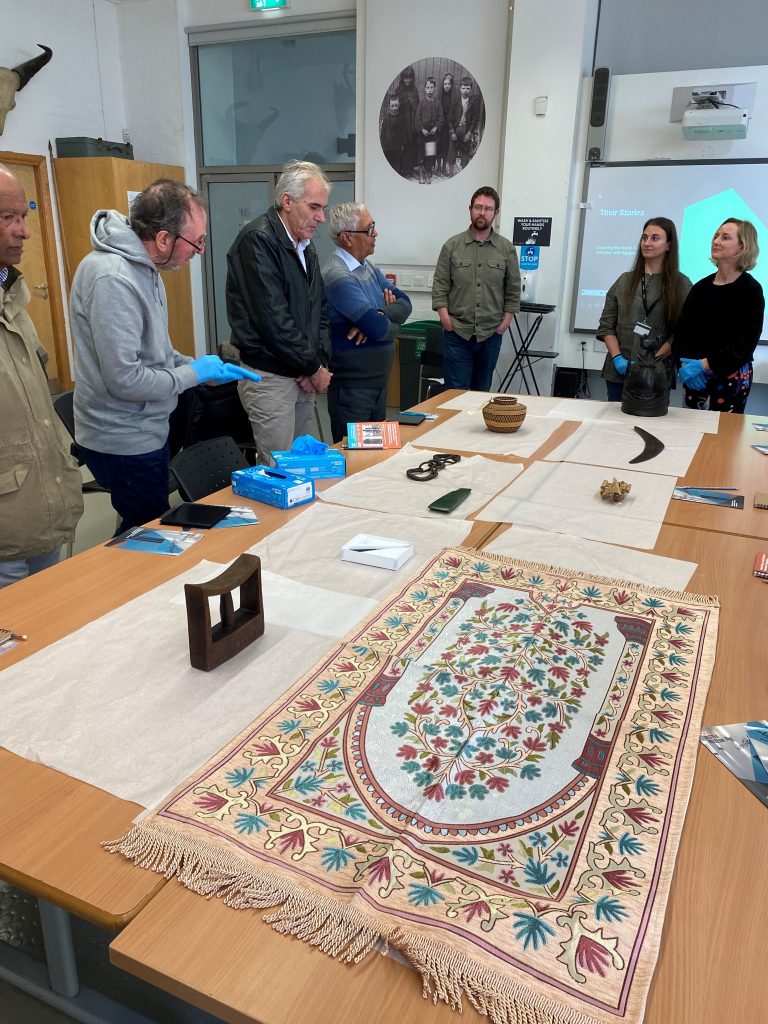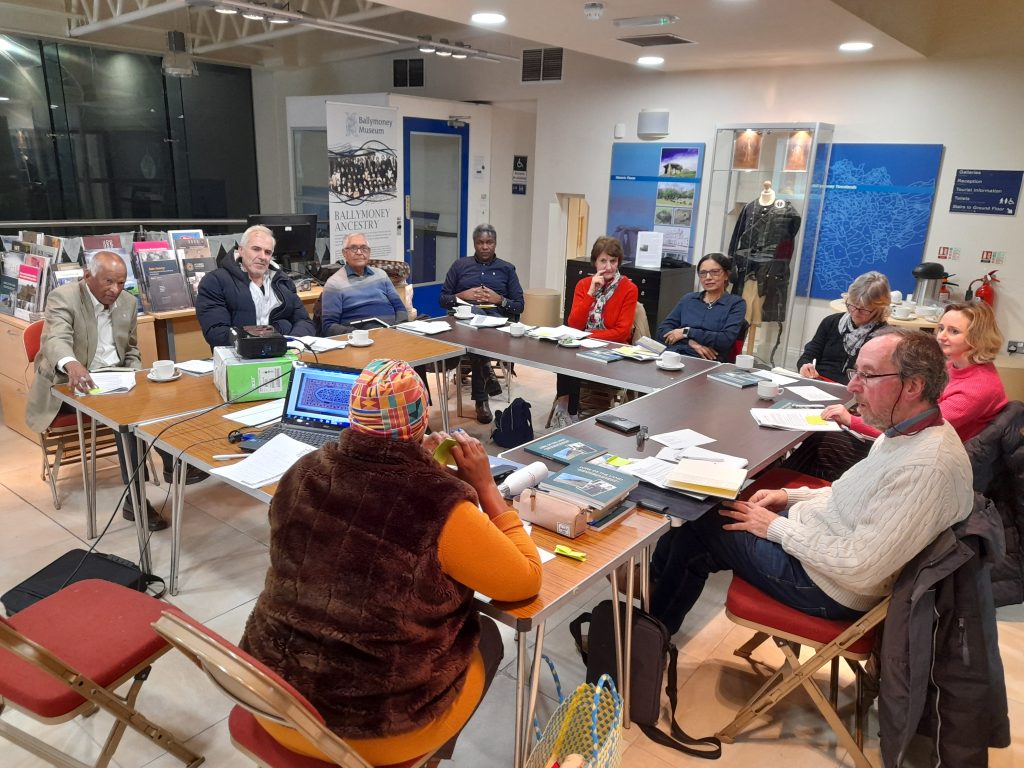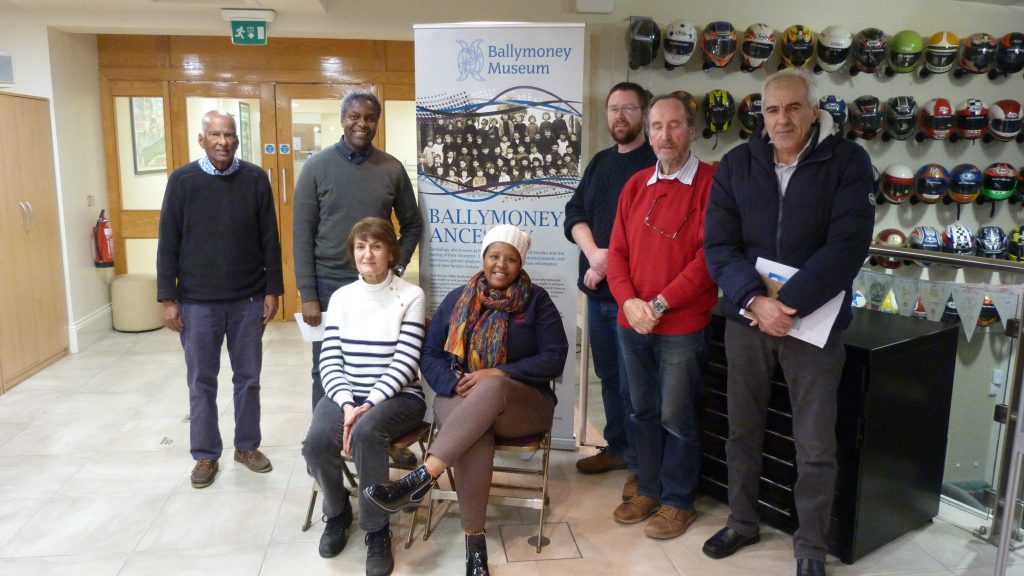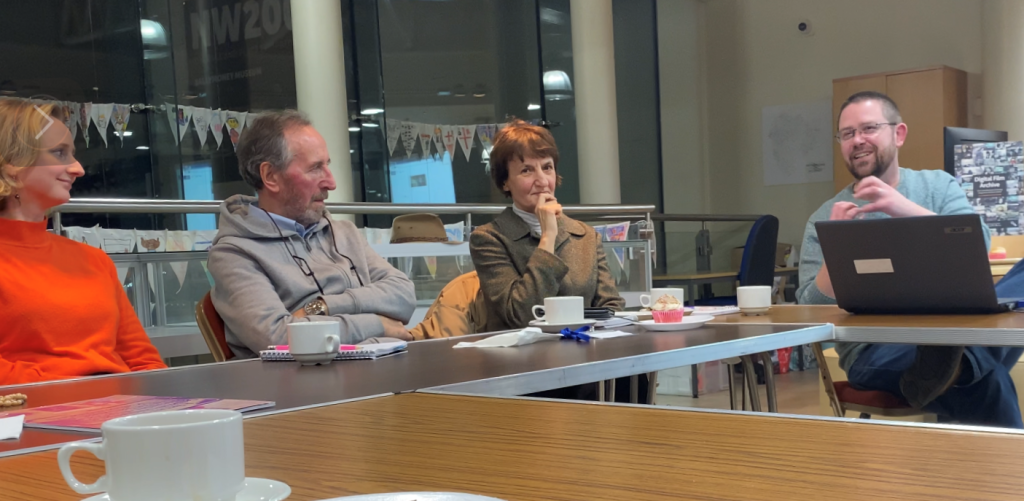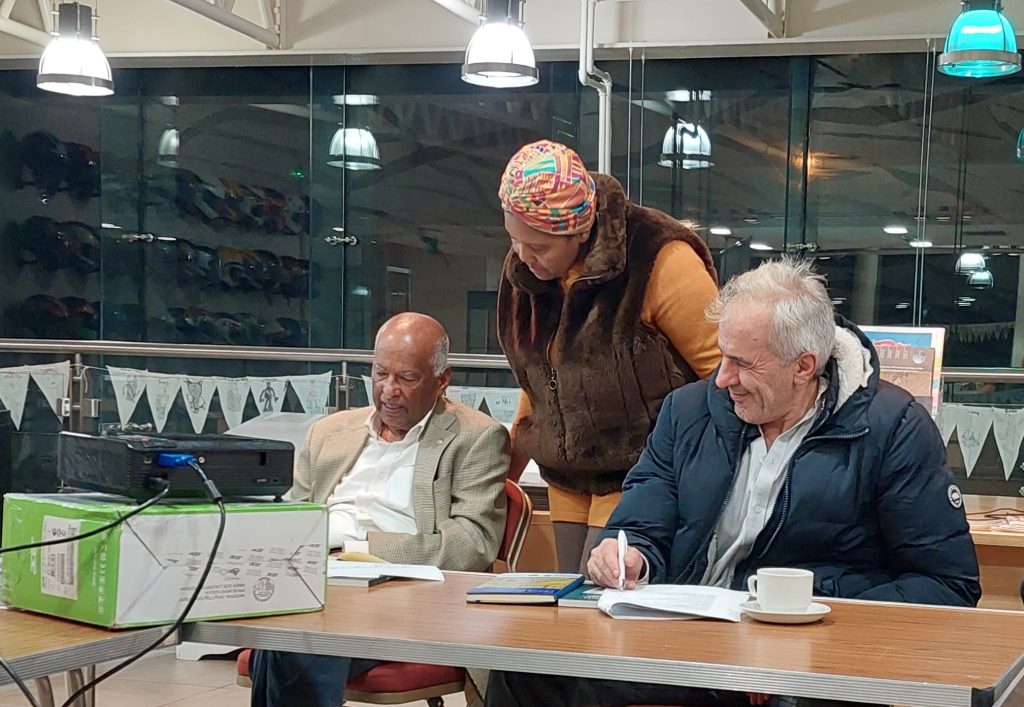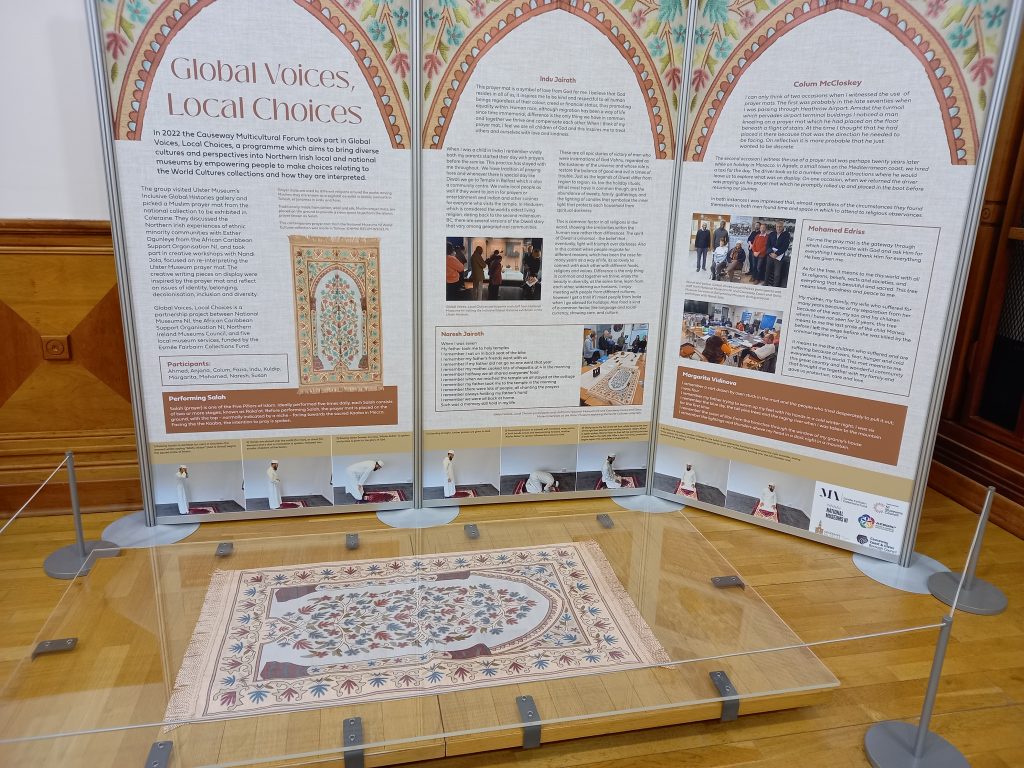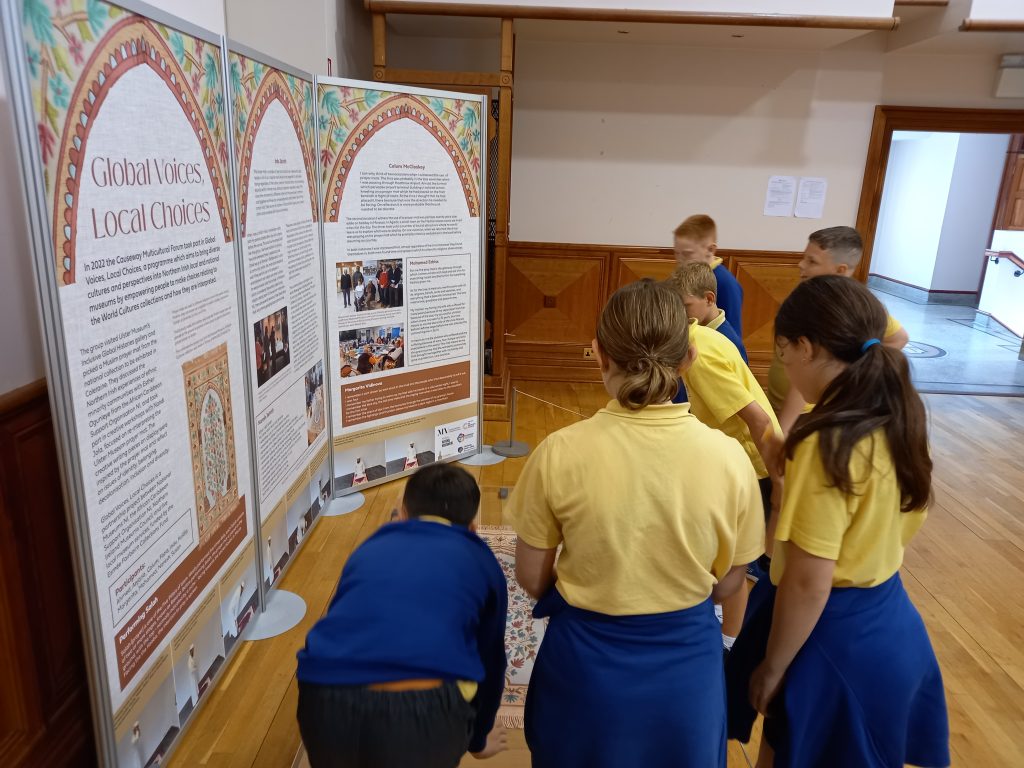
Uncharted Histories Exhibition Panels
6th November 2023
Uncharted Histories: Free Heritage Resources for the Causeway Coast
16th November 2023Global Voices – Reflections on a prayer mat
After visiting the Ulster Museum’s Inclusive Global Histories gallery, members of the Causeway Multicultural Forum chose a Muslim prayer mat as an item from the national collection to be exhibited in Coleraine as part of A World of Stories. The choice of object was an enlightening one as few of the members of the group were themselves Muslim. However, the group elected to choose the mat as their object in order to learn more about each other’s cultures.
While all participants, regardless of their religion or culture could connect in some way with the mat and its floral iconography, its selection propelled two of the participants from the background, forward to become the group experts, being able to speak with authority about what the prayer mat meant to them, and how it would be used in their respective cultures.
Over a series of creative writing workshops facilitated by Nandi Jola, participants reflected on memory, identity, inclusion and culture and penned their thoughts, some of which are included below.
I Remember
Naresh Jairath
When I was seven
My father took me to holy temples
I remember I sat on in back seat of the bike
I remember my father’s friends went with us
I remember if my father did not go no one went that year
I remember my mother cooked lots of chapattis at 4 in the morning
I remember half way we all shared every ones food
I remember when we reached at the temple we. All stayed at cottage
I remember my father took me to the temple in the morning
I remember there were lots of people, all chanting the prayers
I remember always holding my fathers hand
I remember we were all back at home.
Such was a memory I still hold in my life.
My Prayer Mat
Indu Jairath
A symbol of love from God for me. I believe that God resides in all of us, it inspires me to be kind and respectful to all human beings regardless of their colour, creed or financial status, thus promoting equality within.
Human race, although migration has been a way of life since time immemorial times, difference is the only thing we have in common and together we thrive and compensate each other.
When I think of my prayer mat, I feel we are all children of God and this inspires me to treat others and ourselves with love and kindness.
When I was a child in India I remember vividly both my parents started their day with prayers before the sunrise. This practice has stayed with me throughout.
We have tradition of praying here and whenever there is special day like Diwali we go to Temple in Belfast which is also a community centre.
We invite local people as well if they want to join in for prayers or entertainment and Indian and other cuisines for everyone who visits the temple.
In Hinduism, which is considered the world’s oldest living religion dating back to the second millennium BC, there are several versions of the Diwali story that vary among geographical communities.
These are all epic stories of victory of men who were incarnations of God Vishnu regarded as the sustainer of the universe and whose role is restore the balance of good and evil in times of trouble.
Just as the legends of Diwali differ from region to region, so, too the holiday rituals. What most have in common though, are the abundance of sweets, family gatherings, and the lighting of candles that symbolise the inner light that protects each household from spiritual darkness.
This is common factor in all religions in the world, showing the similarities within human race rather than differences. The spirit of Diwali is universal-the belief that , eventually light will triumph over darkness.
Also in this context when people migrate for different reasons, which has been the case for many years as a way of life, its so lovely to connect with each other with different foods, religions and values.
Difference is the only thing in common and together we thrive, enjoy the beauty in diversity, at the same time, learn from each other, widening our horizons.
I enjoy meeting with people from different cultures, however I get a thrill if I meet people from India when I go abroad for holidays. Also food is kind of a common factor, like language and social currency, showing care, and culture.
A Poem on Love and Compassion
Indu Jairath
It revolves around most human beings
no body can be immune from it
It has no colour or form
the symptoms of empathy are many
can feel it in the emotions.
Good or bad
white, yellow, brown or black
same red blood inside all
interconnected in many ways
all humans want to be loved and heard
in the family of things.
Prayer Mats
Colum McCloskey
I can only think of two occasions when I witnessed the use of Prayer Mats. The first was probably in the late seventies when I was passing through Heathrow Airport. Amidst the turmoil which pervades airport terminal buildings I noticed a man kneeling on a prayer mat which he had placed on the floor beneath a flight of stairs. At the time I thought that he had placed it there because that was the direction he needed to be facing. On reflection it is more probable that he just wanted to be discrete.
The second occasion I witness the use of a prayer mat was perhaps twenty years later while on holiday in Morocco. In Agadir, a small town on the Mediterranean coast, we hired a taxi for the day. The driver took us to a number of tourist attractions where he would leave us to explore what was on display. On one occasion, when we returned the driver was praying on his prayer mat which he promptly rolled up and placed in the boot before resuming our journey.
In both instances I was impressed that, almost regardless of the circumstances they found themselves in, both men found time and space in which to attend to religious observances.
I Remember
Colum McCloskey
I remember sucking my thumb
I remember wearing gutties
I remember having a tennis ball with my name on it
I remember candy floss and Danny Boy Toffee
I remember donkey rides back to the field
I remember wringing out my togs on a wooden mangle
I remember a wooden cupboard out in the yard to keep food cool
I remember coal coke and slack stacked up in the yard
I remember cats, lots and lots of cats
I remember sash windows with broken window cords
I remember broken slates all over the street.
I remember
Margarita Vidinova
I remember a cart drawn by oxen stuck in the mud and the people who tried desperately to pull it out, I was four
I remember my father trying to warm up my feet with his hands in a cold winter night, I was six
I remember the blue sky, the tall pine trees and the raging river when I was taken to the mountain for the first time
I remember the scent of lilac from the branches through the window of my granny’s house
I remember the lightings and thunders above my head in a dark night in a mountain.
Bayrakli Jamia
Margarita Vidinova
Travelers crossing Bulgaria are always amazed by the numerous mosques scattered over the country, although the most widely practised religion is Christianity. Most of them were built during the five century Ottoman rule, when the Bulgarian state had ceased to exist. The Ottoman conquerors also brought their religion with them, which they tried to impose with unbelievable savagery, making them even less popular.
There is a mosque in Samokov, a small town in Bulgaria known as Bayrakli jamia or Bayrakli mosque. Jamia is an Arabic word meaning place for gathering. The mosque was built around 1845 ordered by a Turkish governor. At that time, Samokov was a busy industrial town due to iron processing. It began to decline after the Liberation and the mosque fell into disrepair after the Turks left the country. It was abandoned and remained in ruins for a long time. Trees and weeds grew on the top of the wooden roof.
The mosque was fully restored in 1966 with a grant from the state and was turned into a museum. Its architecture is typical for ottoman mosques in Balkans, but some of the elements strongly resemble those used in old Bulgarian houses. It has a wooden roof covered with tiles and wooden vaults with arches on all sides that create a feeling of home comfort.
When the people performing the restoration works entered the mosque, they found an old praying mat covered with dust and dirt from the oil lamps of the chandeliers. They were almost ready to throw it out when they noticed the graffiti below it. Three names written in Bulgarian alphabet could barely be seen on the dusty half-decayed floor. The names were Jovan, Risto and Kosto, Bulgarian male names. Were these the names of Bulgarian builders who built the mosque in such a way that it reminded them of their own homes, or were they the master painters who painted the frescos? We will never know. Inside, the fully restored frescos representing threes, vases with flowers, shells and garlands shine cheerfully under the light that penetrates from the fourteen windows creating a magical environment for the visitors.
Prayer Mat
Mohamed Edriss
For me the pray mat is the gateway through which I communicate with God and ask Him for everything I want and thank Him for everything He has given me.
As for the tree, it means to me this world with all its religions, beliefs, sects and societies, and everything that is beautiful and sacred. This tree means love, goodness and peace to me.
My mother, my family, my wife who suffered for many years because of my separation from her because of the war, my son and his children whom I have not seen for 12 years, this tree means to me the last smile of the child Marwa before I left the siege before being killed by the criminal regime in Syria.
It means to me the children who suffered and are suffering Because of wars, fear, hunger and cold everywhere in this world, this mat means to me this great country and the wonderful community that brought me together with my family and gave us protection, care and love.
سجادة الصلاة بالنسبة لي هي البوابة التي من خلالها أتواصل مع الله وأسأله عن كل ما أريد وأشكره على كل ما أعطاني إياه. أ أما الشجرة فهي تعني لي هذا العالم بكل أديانه ومعتقداته ومذاهبه ومجتمعاته ، وكل ما هو جميل ومقدس. هذه الشجرة تعني لي المحبة والخير والسلام.
أمي وعائلتي وزوجتي التي عانت لسنوات عديدة بسبب انفصالي عنها بسبب الحرب وابني وأطفاله الذين لم أرهم منذ ٢١ عامًا ، هذه الشجرة تعني لي آخر ابتسامة للطفل مروة قبل أن أغادر الحصار قبل أن يقتلني النظام المجرم في سوريا.
تعني لي الأطفال الذين عانوا ويعانون بسبب الحروب والخوف والجوع والبرد في كل مكان في هذا العالم ، هذه الحصيرة تعني لي هذا البلد العظيم والمجتمع الرائع الذي جمعني مع عائلتي وقدم لنا الحماية والرعاية و الحب.
Sajadat alsalaat bialnisbat li hi albawaabat alati min khilaliha ‘atawasal mae allah wa’as’aluh ean kuli ma ‘urid wa’ashkuruh ealaa kuli ma ‘aetani ‘iiaahu. A
‘amaa alshajarat fahi taeni li hadha alealam bikuli ‘adyanih wamuetaqadatih wamadhahibih wamujtamaeatih , wakuli ma hu jamil wamaqdisi. Hadhih alshajarat taeni li almahabat walkhayr walsalamu.
‘umiy waeayilati wazawjati alati eanat lisanawat eadidat bisabab ainfisaliin eanha bisabab alharb waibni wa’atfalih aladhin lam ‘arham mundh 12 eaman , hadhih alshajarat taeni li akhir aibtisamatan liltifl marwat qabl ‘an ‘ughadir alhisar qabl ‘an yaqtulani alnizam almujrim fi suria.
Taeni li al’atfal aladhin eanawa wayueanun bisabab alhurub walkhawf waljue walbard fi kuli makan fi hadha alealam , hadhih alhasirat taeni li hadha albalad aleazim walmujtamae alraayie aladhi jamaeani mae eayilati waqadam lana alhimayat walrieayat w alhab.
Prayer Mat
Agrippa Njanina
My story will not change. My Message remains the same everywhere I go
Before kneeling on me to say any prayer- look closer my brown background- the symbol of soil
Look at all the small trees individually growing out of that soil
The roots cross and interweave underneath seeking the same nutrition
To gain a share of the same life. Look closer they are the seeds of the bigger tree, like the branches of the bigger tree in the centre of space- the connectedness
Embroidered within a border, all as one all connected same size same colours, different colours
That is the message I take everywhere, now as you kneel , know you are part of one bigger whole now meditate on your connection to others.
I Remember
Agrippa Njanina
I remember the loveliest kind sunrises eastward across the Nzombe stream
I remember herding cows and milking them with friends
I remember the magnificent Gombe mountain in the distance from the big mumve tree near the anthill
I remember breaking watermelons and shelling fresh peanuts and eating them in the field
I remember my mother’s giggles and many of her melodies
I remember wasp stings and getting a kick on the knee by a cow
I remember the cloud of dust when the buses from the city raced down the gravel road
I remember my mother hiding her face to tenderly request my self-control
I remember getting on the Tombs bus to Gweru city for the first time
I remember detesting the city
I remember the stomach-turning odour of smoke, diesel and perspiration on the bus
I remember admiring the clock tower immediate the Midlands Hotel
I remember the aroma of pies passing the Waldorf Café
I remember getting home late after spending my bus fare
I remember being stunned by traffic lights.
I remember white people in pickup trucks and their dogs and black servants in the back
I remember my father in white nursing regalia and my admiration of him
I remember losing my first pair of school shoes in the school garden and the intense penalty
I remember the freezing winter mornings and nights in Gweru
I remember being sick of coal
I remember sweets called ‘Niggas’
I remember missing my mother while listening to Mrs Bepete the teacher
I remember the school clerk letting me out class after Mrs Bepete had thought it a good idea to lock me in during lunch
I remember long, never-ending school terms delaying my reunion with mother
I remember taking the blankets out to the line every morning to dry
I remember the food when aunties and uncles visited.
Click here to view the Global Voices, Local Choices exhibition panels
Click here to find out more about the exhibition

The project was made possible with the support of The Executive Office’s District Councils Good Relations Programme.

